 |
 |
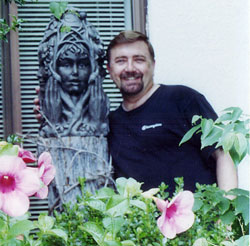
|
|
Ralph Urgolities, Orthotist, Director of the Orthotic Prosthetic Lab, Walter Reed Army Medical Center, Washington, D.C.
|
1. I chose this career because...
2. My typical workday involves...
3. Exciting tools and techniques of the field …
4. What I like best/least about my work …
5. My career goals are …
6. When I’m not working, I like to …
7. The advice I give my children…
|
|
1. I chose this career because...
|
Back to Top

|
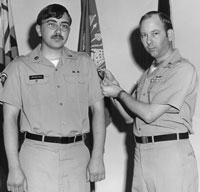
|
|
Ralph Urgolities during his early years in the Army as a conscientious objector.
|
I chose to become an orthotist because I was fascinated with the mechanical sciences in industry. Orthotists build biomechanical devices that assist patients during rehabilitation by preventing, allowing or restricting movement of a part of their body. Some patients will only need the device temporarily, while others will need it for their whole life. I get an extreme amount of personal satisfaction by seeing a patient get up from a wheelchair and walk for the first time, knowing that the orthotic I built made that difference for the patient.
A Blend of My Parents
My father was an aircraft mechanic and my mother was an Army nurse during World War II. I emulated my father, who had great mechanical ability, and my mother, whose mission during the war was to help heal the wounded.
A Life-Changing, Career-Altering Experience
I was drafted into the Army from college during the Vietnam conflict as a conscientious objector and served as an Army Medic. While preparing to go to Vietnam, with a group of Army Medics, I was injured on a physical training obstacle course. I broke my leg so badly that I was unable to accompany the group. Instead, I stayed in the U.S. and had a brace built for my leg to help me walk. I knew from that moment that I wanted to go to school for training to make braces or limbs. When the Army gave me a choice of schools to attend, I chose the Academy of Health Sciences in Fort Sam Houston, Texas, where I was trained as an orthotist.
Career Progression
My career has progressed from laboratory bench work to now holding the position of Director of the Orthotic Prosthetic Lab at Walter Reed Army Medical Center in Washington, D.C. This means that I do both management tasks and work with patients.
Education and Certification
- Bachelor's of Applied Science, Orthotics, Creighton University, Omaha, Nebraska
- Orthotist, training and certification, Academy of Health Sciences, Fort Sam Houston, Texas
|
|
2. My typical workday involves...
|
Back to Top

|
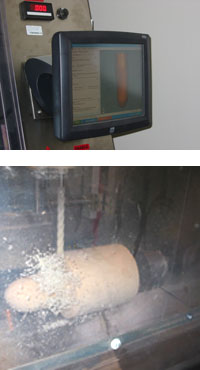
|
|
Ralph Urgolities uses a computer (top) to carve a plaster model for a prosthetic leg (bottom).
|
My typical workday centers on my many duties as Director of the Orthotic Prosthetic Lab at Walter Reed Army Medical Center in Washington, D.C. A typical workweek for me includes 80% management of logistics and personnel with 20% clinical practice in my filed of spinal orthotics and scoliosis management.
My Main Responsibilities:
- Consult to medical practitioners at Walter Reed Army Medical Center in orthotics and prosthetics, and occasionally consult to Brooke Army Medical Center in San Antonio, Texas, or the National Naval Medical Center in Bethesda, Maryland
- Coordinate the many technologies used for computer-assisted orthotic prosthetic fabrication
- Oversee and review the orthotic and prosthetic devices produced by the lab to ensure highest quality and design
- Supervise the assignments of the 25 orthotic and prosthetic practitioners who work in the lab, which includes establishing priorities and evaluating staff performance
- Interview candidates for positions and make recommendations for job appointments
- Make recommendations for awards, promotions and disciplinary action for my employees
- Speak about orthotics and prosthetics in both military and public forums
Most recently I was a part of a special presentation on the History Channel, and I have given guest lectures at the Smithsonian Institutions in Washington, D.C., and the National Institutes of Health in Bethesda, Maryland.
|
|
3. Exciting tools and techniques of the field …
|
Back to Top

|
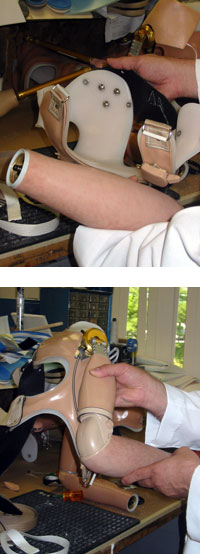
|
|
Ralph Urgolities uses a prosthetic harness with metal electrodes (top) to amplify the nerve muscle signals stimulated by chest muscle contractions. This enables the attached prosthetic arm to move (bottom).
|
If you like to work with your hands, there are many special tools that have been developed over the last 10 years in the orthotic prosthetic field. Many of the older methods, such as negative casting, require more motor-coordination, while most of the newer methods involve computers and imaging. Some of these methods include:
- negative casting: pouring a model of the orthotic or prosthetic and then carving modifications into the model to develop the device the physician prescribed that will fit the patient
- magnetic scanning, laser scanning and photometric scanning: multi-step processes that use a computer image of the patient’s body to create and fit the device to the patient. These processes involve:
- obtaining an image of the part of the patient’s body that needs the orthotic or prosthetic
- sending it to the computer that modifies the device directly on the screen on a virtual 3D model of the patient
- sending this modified image via the internet to a lab that builds the device, or sending the image to our own 3D carver
- fitting the brace or limb to the patient, which takes a few hours
Microprocessor Knees – Best Improvement in the Prosthetic Field
The invention of microprocessor knees in the last 10 years has been one of the best improvements in the prosthetic field for patients who have lost their leg above the knee. Microprocessor knees are prosthetic knees that have a computer chip inside them to help the patient cope with the difficulties of having a prosthetic knee. We can program the knee to assist the patient during different phases of walking, such as heel strike, mid stance and push-off. Although the body would normally complete these phases by itself, a patient who has lost a leg must retrain his or her body to use the prosthetic knee to do this. The greatest assistance for new amputees wearing a microprocessor knee is a feature called “stumble control” that prevents them from falling.
|
|
4. What I like best/least about my work …
|
Back to Top

|
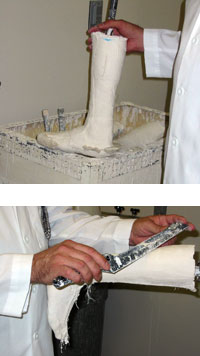
|
|
Ralph Urgolities displays a plaster model of a patient's leg (above). He uses a special instrument to smooth the surface before vacuum forming it into an ankle foot orthotic (bottom).
|
What I like best about my work is that no two days are ever the same. Every day presents a different challenge, a different set of problems and a different set of opportunities. The tangible rewards of my job are easy to see: the young soldier who was previously in despair and is now walking with an ear-to-ear smile; the parents who were once devastated and now have reason to hope. They cry and then you cry. Those are true rewards.
What I like least about my work are the long hours and hard-to-meet deadlines that are always a part of my job. I dislike the huge volume of government forms and contracts that must be filled out for our patients, but I have accepted that these are necessary if we want to provide quality care for our patients.
|
|
5. My career goals are …
|
Back to Top

|
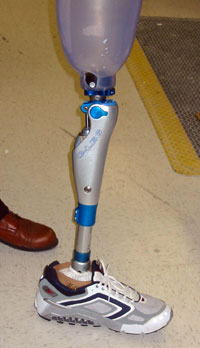
|
|
A leg prosthesis is fitted onto a prosthetic foot which enables an amputee to walk or run without falling.
|
My career goals are to become board certified in prosthetics, which I will do very soon. Although I am already certified in orthotics, I am becoming certified in prosthetics because the two fields are inseparably linked and this double-certification is inevitable if one’s passion for this field is deep enough.
Over the next five to eight years, I see myself being heavily involved in helping to plan the restructuring of the military medical system. This will involve planning and organizing the new facilities, infrastructure and staffing of the military medical services in the Washington, D.C. area. I hope that my last years of work for the U.S. military will be spent ensuring that the new Walter Reed National Military Medical Center's Orthotic and Prosthetic Lab establishes itself as one of the finest in the world.
After my retirement, I have considered becoming an advocate for providing improved orthotic and prosthetic care to wounded soldiers worldwide, particularly in Eastern Europe, where my family has roots.
|
|
6. When I’m not working, I like to …
|
Back to Top

|
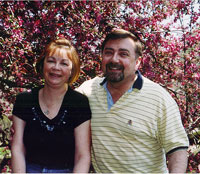
|
|
| |
Ralph Urgolities enjoys gardening with his wife.
|
When I’m not working, I like to spend time with my wife remodeling around our home, gardening or working on my family genealogy. My wife and I love to spend as much time as possible with our five adult children, who live all over the country, and our three granddaughters. We also enjoy hosting guests from all over the world.
|
|
7. The advice I give my children…
|
Back to Top

|
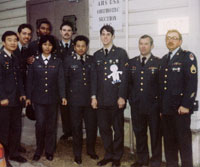
|
|
| |
Ralph Urgolities dressed in full uniform for his graduation from the Academy of Health Sciences in Texas.
|
The advice I have given my children and grandchildren and would give to any young person thinking about the future is: Study all kinds of subjects – don't rule anything out – and try your best at each one so that you get a feel for what you really like and what you're good at. Think about what's really important in life. What will bring you satisfaction, not only when you get your paycheck but also when you look back on your life and the difference you have made on the planet? I was lucky to find a field that combined my mechanical interests with my belief that the best work is work that helps others.
|
|
|
|
 |